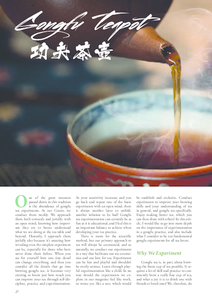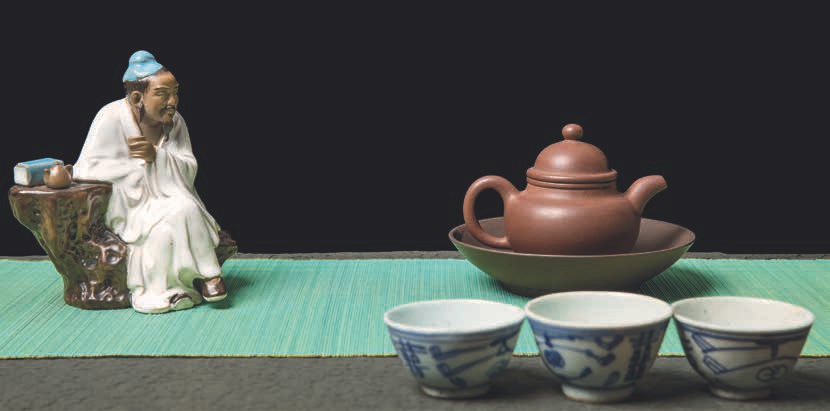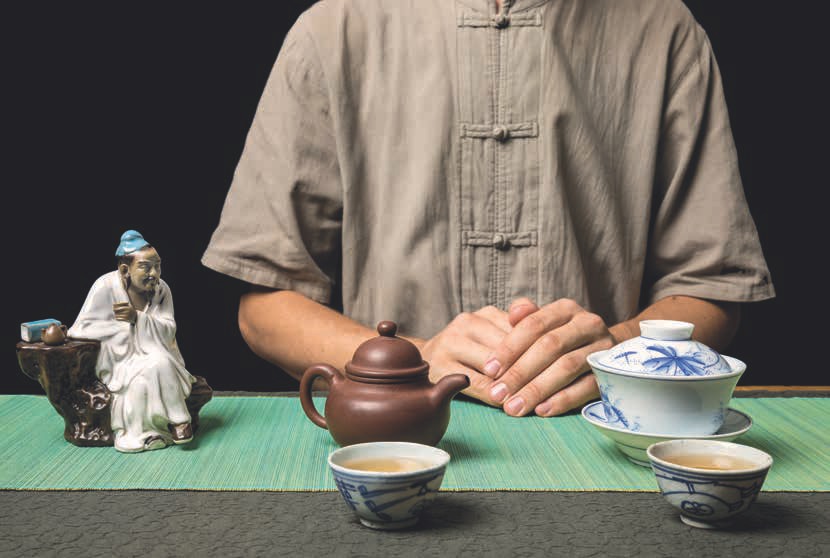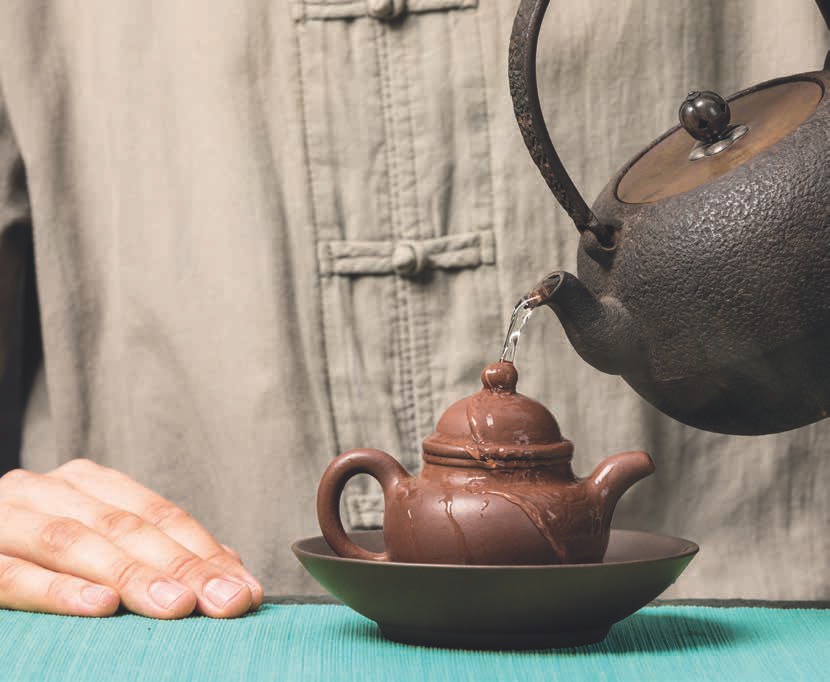
 |
|

One of the great treasures passed down in this tradition is the abundance of gongfu tea experiments. At our Center, we conduct them weekly. We approach them both seriously and jovially, with an open mind, knowing how important they are to better understand what we are doing at the tea table and beyond. Honestly, I approach them joyfully also because it's amazing how revealing even the simplest experiment can be, especially for those who have never done them before. When you see for yourself how one tiny detail can change everything, and then you consider all the details that go into brewing gongfu tea, it becomes very exciting to know just how much you can improve your tea through self-discipline, practice and experimentation. As your sensitivity increases and you go back and repeat one of the basic experiments with an open mind, there is always another layer to unfold, another infusion to be had! Gongfu tea experimentation can certainly be as fun as it is educational, and I feel this is an important balance to achieve when developing your tea practice.
There is room for the scientific method, but our primary approach to tea will always be ceremonial, and so naturally, we conduct our experiments in a way that facilitates our tea ceremonies and our love for tea. Experiments can be fun and playful and shouldn't be overly serious. Learn through playful experimentation like a child. In no way should the experiments we explore in our magazine feel like work, or worse yet, like a test, which would be snobbish and exclusive. Conduct experiments to improve your brewing skills and your understanding of tea in general, and gongfu tea specifically. Enjoy making better tea, which you can then share with others! In this article, I would like to go into more depth on the importance of experimentation in a gongfu practice, and also include what I consider to be ten fundamental gongfu experiments for all tea lovers.
Gongfu tea is, in part, about brewing the finest cup of tea possible. It requires a lot of skill and practice to consistently brew a really fine cup of tea, and what a joy it is to drink one with friends or loved ones! We, therefore, do experiments to help us understand all the details that go into brewing gongfu tea. When each aspect is more fully understood, we can begin to make progress and enjoy finer and finer tea. But what defines a fine cup of tea?
Be sure to study up on the Ten Qualities of a Fine Cup of Tea (they are listed on the following pages, but also search the "Past Issues" section of the website or watch our video on this topic, which is on our YouTube channel, for more information), as you will need them as a standard throughout all your experimentation. Though all criteria are partially subjective, we still need them to learn from a teacher and to measure our own progress, so that we have a standard to see that our brewing is improving over time. Without such a standard to strive for, we just brew tea however we like it. Enjoying tea how you like it is fine as a pastime or hobby, but not for "mastery through self-discipline," which is what "gongfu" is. With a properly defined set of qualities to aim for and to gauge our progress, let's take a look at what else comes as a result of doing experiments and why they're important.
First and foremost, when I do experiments, I can then speak from a place of experience. What I have to share about tea isn't just coming from something I read in a book, watched on a video or heard from my teacher, but something I can experience within the framework of my own body, and that's empowering! The more experiments I do, the stronger the foundation upon which I can stand with confidence and talk about tea. I start to understand tea and brewing methods in more and more detail - and details matter for the person of tea. In order to communicate and educate about tea, it is important to fully understand why we are doing what we're doing at the tea table. If nothing is done arbitrarily in gongfu tea, then everything is done with purpose, and the experiments help to reveal that purpose.
We are very fortunate in this tradition, because the traditional gongfu tea brewing method, as developed in southern China, has been preserved by teachers before us and then passed down to our generation. Part of that preservation was a result of doing and teaching many experiments. Having a tradition, a lineage, handed down to us, is important, because we have the criteria we need to experiment. In our tradition, these are the Ten Qualities of a Fine Tea, without which there would be no way to reference "better" or "worse" and all experimentation would, ultimately, be lost in subjectivity. Our tradition also helps contextualize and inform our gongfu experiments in at least three ways:
Traditional gongfu tea has been refined and preserved over hundreds of years - and a tradition has a better memory than any one person. If any changes or modern adaptations are made, I want to know the history behind the decision to make such a change. That's very relevant information, especially when it comes to some of the more prevalent changes in gongfu tea we see nowadays, because it helps us understand why that change was made in the first place, and whether it was a well-thought-out decision. Doing the pitcher experiment listed below is an excellent example of this, if you consider what the pitcher is used for outside of tea, and when and why it was introduced into the modern tea ceremony. I'll leave that up to you to find out.
We also learn about the surface-level, practical reasons behind each aspect of the gongfu brewing method. If you ask someone brewing tea why they're doing what they're doing, they're likely to be able to give a practical reason for it, which is good. But even that ability is being lost today. Without a tradition to provide even a simple, practical understanding of the different aspects of this brewing method, we are left brewing tea however we like it, and there is no room for progress with that approach.
Finally, every aspect of tea preparation has a deeper meaning to it. We are very fortunate in that the experiments taught and handed down to us have maintained their spiritual lessons. They are often good life lessons, too.
As you do some of the experiments below, always ask yourself what's being lost or gained and consider what that means with regards to the most important parts of tea service. Sometimes, an experiment will demonstrate a practical benefit to using a certain piece of teaware, while at the same time, sacrificing something very deep and important to your tea ceremony. Is it worth it? Sometimes it is and other times it isn't. The only way to really know is to do the experiments, consider all the pros and cons, and on what occasion certain sacrifices might be acceptable.
As you start to understand the historical, practical and deeper lessons of an experiment, together with the gains and losses, you can really start to make educated decisions on how best to serve tea!
When we finally sit down to complete a few experiments and consider the history of them, along with the practical and deeper lessons, we can quickly narrow down the reasons for making changes and adaptations to a three-hundred-year-old tea brewing tradition. Some adaptations are great and improve our tea, others are market-driven. Knowing which is which is important, so that we don't buy things we don't need or use teaware and/or brewing methods that do not bring out the best in a tea.
Of course, you don't need these three contexts to inform your experimentation. With the Ten Qualities of a Fine Tea, or another standard that you observe systematically throughout your experimentation, you can still learn and grow through conducting our tradition's experiments and, perhaps more importantly, develop the ability and verve to create your own experiments!
For each experiment below, it is important to use a tea that is very familiar to you. I often use a lightly oxidized tea and brew it in smaller amounts, about 1 - 2 grams, depending upon the size of the brewing vessel. If you use too much of a dark, aged or complex tea, it will be distracting and difficult to notice the subtle differences when comparing teaware and brewing methods.
You'll want to have a notebook to record your findings. Write as many details as you can, including date, materials used, procedure, observations and other remarks. This will be very useful in the future when you come back to do the same experiment again. It will also help you gauge your progress.
As you record your observations, remember, it's not about what you think is better or worse, but any differences you notice. Being able to notice that there is a difference based on the teaware or method used is good enough. Focus on the ten qualities listed above, and set flavor and aroma aside as much as possible for the time being (this is also why using a lighter brewed tea is helpful). How does the tea feel in your mouth and in your body? Maintain a quiet ambiance throughout each experiment so everyone can focus on the tea. Feel free to discuss the outcomes once everyone is finished.
Note that we won't reveal the conclusions of any of these experiments. That is completely left up to you! It's more fun learning through your own experience anyways, and there's no pressure to find a right or wrong outcome. Always stick to your experience, and be open to the fact that next time a new subtlety may reveal itself to you that you weren't sensitive to the first time. We're not here to convert anyone to our brewing method, but to give you a platform upon which to have fun and learn to make better tea through your own experience.
This practice of gongfu tea must be a labor of love and passion. Wu De always tells us that the best tea is tea made with love, referring to the way the tea is grown, processed and prepared. If the tea follows the heart in these three ways, then it is made in alignment with Nature, Heaven and Human, and we have found the Dao through our tea practice. But we must become these teachings; we must live the Way, rather than just contemplating it or philosophizing about its subtleties in this magazine. This is why we have included so many of our experiments in these pages over the years.
Remember, gongfu means mastery through self-discipline, and in order to master gongfu tea, we need to first define what a fine cup of tea is. If you don't, then there is nothing to aim for and no way to make progress. If it's just defined as however you like it, there's no way to get better at it - you cannot improve "however you like it." A properly defined set of qualities allows us to evaluate our tea, discuss it with others and learn through experimentation, in order to make progress with the guidance of a teacher.
Of course, let us also remember that quality is arbitrary. Tea is an art, not a science, and there is no such thing as complete objectivity. Our observations will always be subjective to some degree. With the list of qualities below, we will attempt to bring in as much objectivity as possible, with the understanding that it is, however, ultimately arbitrary. With that being said, and for the sake of experimentation and progress, we use this standard set of qualities, by which we measure our gongfu tea. Because opinion-based qualities like flavor and aroma are so subjective, we have instead gone down to mouthfeel. Sensations and texture in the mouth offer much more room for agreement.
The best and easiest way to improve your tea is to improve your water. Tea is 98% water, so obviously, better water will go a long way towards helping you make better tea.
What you'll need:For this experiment, buy at least three different kinds of bottled water. Randomly choose two, pour equal amounts into two cups, and drink them side by side, back and forth. Make notes of any differences you notice. Based on the ten qualities listed above, choose one of the two bottles which you feel is more suitable to make tea, and then compare it against the third bottle of water. Remember, water should have no aroma or flavor; it should quench your thirst, and like any good tea, it should be round, smooth, soft and easy to swallow.
Continue with this process of elimination until you've decided which water you feel is most suitable for tea. If you have a good source of spring water, perhaps compare your top bottled water to the spring water, and again, see if you can notice any differences.

This is one of the most important and simplest experiments to do. It's the one I do most often with guests at the Center. It's also an excellent example of why the first line in the gongfu poem is so important...
What you'll need:Heat your water. Before it's fully boiled, pour it into one of the three cups. There is no need to pre-warm your cups. Pour half the water from the first cup into the second cup. Then pour half the water from the second cup into the third cup. The first cup should contain half the water, whereas the last two cups should contain one quarter each. Starting with the last cup, quickly drink back and forth between all three cups, recording your observations as you go. Repeat at least three times, making sure to pour accurately from each cup to the next. You could easily do this experiment with more than three cups.

This is one of my favorite experiments to do. It demonstrates the importance of shape, material and design in your teaware. This is one not to miss, especially in modern times when the use of gaiwans is so prevalent. Why are they so widely used, and when did they become fashionable as brewing vessels in tea shops? What was the motivation here? How were they used long ago?
What you'll need:Weigh about two grams of tea for your gaiwan and for your Purple-Sand teapot. Brew them side by side. If you're confident with both hands, you could steep them at the same time and pour with one vessel in each hand at the same time (I prefer the gongfu pot in my dominant hand and the gaiwan in my off-hand). Otherwise, you can steep one vessel at a time, drink the tea and record your notes. Then, steep in the other vessel. Repeat this at least three times. If you pour into the teapot first and the gaiwan second, switch the order each round.
I notice a tendency in people to top up their kettles once they are low by adding cold water to it and reheating. (I've always wondered what is happening when that cold water hits the remaining hot water.)
What you'll need:For this experiment, I like to heat my water and drink a few cups just to familiarize myself with it. You could also drink a few cups of tea as well. Then, add a cup or so of cold water to your kettle and bring it back to a boil. Even the sounds can be revealing at this point. Once the water has returned to a boil, drink the water again or steep some tea and record your observations.
To really understand when and when not to use a pitcher, this experiment is essential. What are the pros and cons of using a pitcher, and do the sacrifices outweigh the gains? Where and when did the pitcher even come from? What's the most appropriate situation in which to use a pitcher?
What you'll need:Use about two grams of tea in your gongfu teapot. Line up your cups and the pitcher. It's often difficult to preheat all the cups and the pitcher, unless there's only one person, so don't worry. Just steep the tea and pour back and forth into your pitcher and half the cups. Immediately pour the tea from the pitcher into the other empty cups. Take both cups, one with tea from the pot and the other with tea from the pitcher, and drink them back and forth, recording your observations. Repeat at least three times.
This is another eye-opener. Many people think we are cleaning our cups between each steeping, but actually we are preheating them. What for, and does it really make a difference?
What you'll need:As usual, steep a lighter tea that you are familiar with in a smaller amount, about two grams. Preheat half of the cups with boiled water and don't preheat the other half. Pour off the water from the preheated cups into your waste-water basin, and soon afterwards, pour the tea into your cups. Drink both cups back and forth, recording your observations as you go. Repeat two or three times. Move back and forth between the cup that is preheated and the one that isn't, holding both in your hands as you do.

You'll notice we shower our gongfu tea with heated water both before and after steeping the tea inside. The results of this experiment always surprise me.
What you'll need:For this experiment, you prepare three consecutive steepings. For the first round, shower the outside of your pot with hot water, lift the lid and steep the tea. This is called "showers before." Pour the tea into your cup. Drink quietly and record your observations, focusing on the sensations in the mouth. For the second round, only shower the pot after you fill it. This is be called "showers after." Again, pour the tea into your cup, drink and record. For the final steeping, shower before and after steeping: "showers before and after." Drink that cup and record. It's difficult to repeat this experiment once the leaves have been steeped a few times and the pot thoroughly showered. You could simply repeat the experiment later with fresh leaves, or if you're lucky and have three of everything, you could do all the "showers" at the same time.
This one is excellent because it's simple, and most people have different types of cups and rarely consider how big an impact those small cups can have on the quality of the tea. Which ones are actually suitable to make better tea?
What you'll need:Weigh about two grams of tea and brew as you normally would, showering your teapot before and after steeping. If you're doing this experiment with a lot of people or a lot of cups, you can skip pre-warming them. Pour the tea into all your cups and drink back and forth between all of them. Repeat at least a few times, noticing how the shape, size, material or age affects the tea liquor in your mouth.
Our experiments wouldn't be complete without testing the different heat sources out there. There is so much to learn in this fun experiment!
What you'll need:You can do this one with tea or just with hot water. Some people find only water a little difficult to discern the differences, whereas other people find the tea and the time between each steeping too confusing. It's up to you and it's a good idea to try both eventually.
If you have three of the same kettle, then you can fill them with the same volume of water and heat them at the same time. Note that each heat source will heat your kettle at different rates, so you may need to time how long it takes on each heat source, in order to bring them to a boil at the same time.
If you only have one kettle, which is more likely, then you just have to test each heat source one at a time, recording your observations as you go and being patient to heat up the fresh water for each heat source. You only need a little water in your kettle. If you have access to charcoal and a brazier, you will want to drink the water or tea from this heat source first, then move on to the other heat sources. As always, focus on the sensations in the mouth. Think about the quality of the heat as a texture in your mouth. Is it penetrating and structured, or spiky and uncomfortable?

With so many kettles out there, made with different shapes and materials, which one is most suitable to boil water for tea?
What you'll need:Again, this one can be carried out with just water or tea. I prefer to do them with just water in the beginning. This time, you'll want to use one heat source for all the different kettles, drinking the water from each one, recording your observations and moving on to the next kettle. Use a heat source that is easy to control for this experiment, like electric or gas. Each type of kettle has an energy and imparts qualities to the water. Try to not only evaluate the kettles' performance, but see if one is more suitable for certain kinds of teas.
I hope you find these experiments as fun, educational and revealing as I have! No matter your approach to tea, I really believe the experiential understanding gained from conducting these experiments will help you brew finer tea in a way that is suitable to you.
It is also my great hope that these experiments will stimulate some deeper discussions and that some of you will get creative and design your own experiments. If you do, we would love to hear from you through our app, email and social media outlets. We also have many other experiments to share with you as well, should you like to steep a little more mastery through self-discipline. I also hope that these experiments will inspire you to create your own, and to learn to love the process as much as I do.
Remember, this isn't about putting on a white lab coat and sterilizing your teaware, but rather, it's about keeping an open mind and recognizing the differences that result from using different teaware and brewing methods, so that you can make educated decisions in your tea preparation. As always, the most important element in any tea session is you! The heart with which you brew and serve tea trumps all experiments and their conclusions. The best cup of tea is always the one brewed, given and received from the heart. In that way, may your love for tea grow through a combination of mastery through self-discipline, brewing from the heart and joyful experimentation! Happy brewing, everyone!
